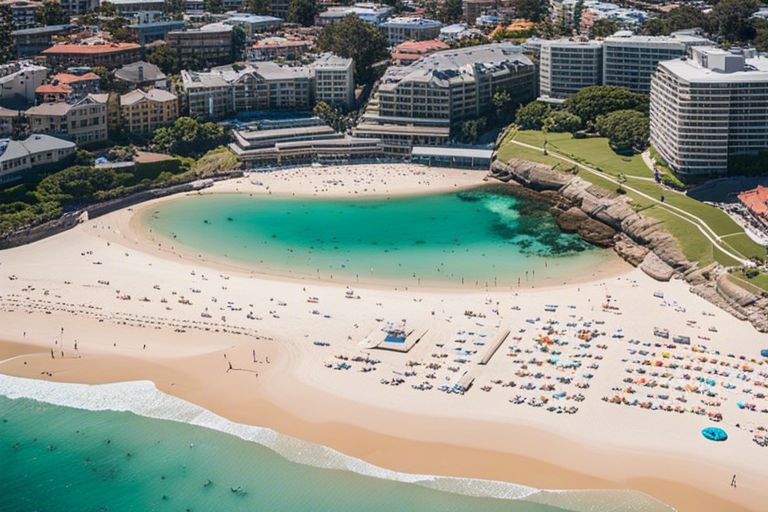Step-by-Step – How To Master Surfing At Bondi Beach
Bondi Beach, known for its iconic waves and surf culture, is the perfect place to master the art of surfing. In this step-by-step guide, we will cover everything you need to know to catch waves like a pro at Bondi Beach. From choosing the right board to mastering techniques, get ready to ride the waves and embrace the surf lifestyle at this famous Australian beach.
Key Takeaways:
- Get the right gear: Having the right surfboard and wetsuit is vital to mastering surfing at Bondi Beach.
- Learn surf etiquette: Understanding the rules of the water and respecting other surfers is important for a safe and enjoyable surfing experience.
- Practice regularly: Consistent practice and dedication are key to improving your surfing skills and mastering the waves at Bondi Beach.
Understanding Bondi Beach Surfing Conditions
Factors Affecting Wave Height and Direction
While Bondi Beach is known for its consistent waves, understanding the factors that affect wave height and direction is vital for mastering surfing here. The size and shape of waves at Bondi Beach are influenced by the tide, winds, and swell direction.
- Wind speed and direction play a crucial role in creating the surf conditions.
- The tide can significantly affect the size and quality of waves at different times of the day.
- Swell direction determines the angle at which waves approach the beach, impacting their shape and intensity.
Any aspiring surfer looking to ride the waves at Bondi Beach should pay close attention to these factors and how they interact to optimize their surfing experience.
Reading the Tides and Swells
One of the key factors in understanding Bondi Beach surfing conditions is reading the tides and swells. There’s a direct correlation between the tide level and wave height at Bondi Beach, with higher tides typically producing larger waves. Plus, monitoring swell forecasts can help surfers anticipate when the best waves will hit the beach.
Identifying Rip Currents and Safe Zones
Understanding rip currents and safe zones is crucial for surfers at Bondi Beach. Zones with strong rip currents can be dangerous and should be avoided, while safe zones with calmer waters are ideal for surfing beginners. It’s important to familiarize yourself with the beach’s layout and identify potential rip currents to stay safe while surfing.

Choosing the Right Equipment
Selecting the Perfect Surfboard for Bondi Beach
With so many surfboards on the market, it can be overwhelming to choose the right one for Bondi Beach. It is necessary to select a board that matches your skill level and the type of waves you will encounter. For beginners, a longboard is often recommended as it provides stability and easy paddling. Intermediate surfers may opt for a funboard or a fish-shaped board, offering a balance between stability and maneuverability. Advanced surfers might prefer a shortboard for more aggressive turns and maneuvers in the powerful waves.
Wetsuit and Rash Guard Essentials
With the waters of Bondi Beach being on the cooler side, wearing the appropriate wetsuit and rash guard is crucial for an enjoyable surfing experience. A wetsuit will keep you warm and protected from the elements, while a rash guard will prevent irritation and chafing from your board. Make sure to choose a wetsuit that fits snugly to prevent water from seeping in but allows for freedom of movement.
Right wetsuit and rash guard selection can make a significant difference in your comfort and performance in the water. Look for high-quality materials and a good fit to ensure that you stay warm and comfortable throughout your surf session.
Leash and Fins: Why They Matter
Matter
For instance
Mastering the Basics of Surfing
Now, as you initiate on your surfing journey at Bondi Beach, it’s crucial to master the basics of surfing to ensure a successful and enjoyable experience in the water.
How to Paddle Efficiently and Catch Waves
Surfing begins with paddling efficiently to catch waves. The key is to position yourself properly on the board, lying flat with your chest down and using your arms to paddle smoothly through the water. As you spot a wave approaching, paddle with increased intensity to match the speed of the wave and propel yourself forward. Timing is crucial, so ensure you catch the wave just as it begins to break to ride it successfully.
Tips for Standing Up and Balancing on the Board
If you’re a beginner, mastering the art of standing up and finding your balance on the board may seem challenging at first. Start by practicing the “pop-up” technique, where you push yourself up from lying flat to a standing position in one smooth motion. Keep your feet shoulder-width apart, parallel to the stringer (the middle line of the board), and maintain a low center of gravity to improve stability. The more you practice, the easier it will become to find your balance and ride the waves effectively.
- The key to finding balance on the board is to engage your core muscles to stabilize your body.
- Remember to keep your gaze forward and focus on a point in the distance to help maintain your balance while riding the waves.
Understanding Surfing Stances and Foot Placement
Catch waves effectively by understanding the different surfing stances and foot placement techniques. The three primary stances in surfing are regular, goofy, and switch. Regular stance involves placing your left foot forward, while goofy stance involves placing your right foot forward. Switch stance refers to changing your foot positioning while riding the wave to perform maneuvers effectively. Experiment with these stances to find which one feels most comfortable and allows you to maintain control on the board.
Understanding the ideal foot placement on the board is crucial for maintaining balance and control while surfing. Your front foot should be positioned near the middle of the board, perpendicular to the stringer, while your back foot should be slightly angled for stability. By adjusting your foot placement based on the wave conditions and your intended maneuvers, you can improve your overall performance and enjoyment in the water.
Advanced Surfing Techniques for Bondi Beach
After mastering the basics of surfing at Bondi Beach, it’s time to take your skills to the next level with advanced techniques. Here are some tips and tricks to help you become a pro surfer at this iconic beach:
- How to Turn and Control Your Board
- Always assess the wave height and power before paddling out.
- Adjust your positioning on the board to match the wave’s speed and power.
| Technique | Description |
| Bottom Turn | Shift your weight towards the wave and use your back foot to pivot the board. |
| Top Turn | Lean back and use your front foot to turn the board off the top of the wave. |
Factors to Consider When Surfing Overhead Waves
Now, when facing overhead waves at Bondi Beach, you need to be aware of certain factors to ensure a successful surf session. Factors to consider include wave size, speed, and the length of the ride.
Your positioning on the board is crucial when surfing overhead waves. Perceiving the right moment to execute maneuvers and make critical decisions can make all the difference in catching the perfect wave.
Mastering Cutbacks and Re-entries
Cutbacks
With cutbacks and re-entries, you can add style and power to your surfing technique, making your ride more dynamic and impressive. By mastering these maneuvers, you can flow smoothly from one turn to the next, maintaining momentum and control throughout your ride.

Safety Precautions and Emergency Procedures
Identifying and Avoiding Hazards in the Water
Emergency: Before heading out into the surf, it’s crucial to be aware of potential hazards in the water. Keep an eye out for rip currents, submerged rocks, and other surfers to avoid collisions. Always remember to swim between the red and yellow flags, which indicate the safest areas for swimming and surfing.
What to Do in Case of a Wipeout or Injury
Wipeout: If you find yourself in a wipeout or injured while surfing, try to stay calm. Signal for help by raising one arm above your head and waving to get the attention of lifeguards or other surfers. If you’re able to, paddle to the shore using your surfboard for support.
Safety: It’s imperative to prioritize safety in the water. Never surf alone, and always be mindful of your limitations. If you or someone else is injured, seek help immediately and follow basic first aid procedures to ensure everyone’s well-being.
Basic First Aid for Surfing Injuries
You: It’s important to have a basic understanding of first aid for surfing injuries. Be prepared to treat cuts and scrapes with antiseptic wipes and bandages. In the case of more severe injuries, such as sprains or fractures, immobilize the affected area and seek professional medical help as soon as possible.
Precautions: Always wear appropriate safety gear, such as a leash and rash guard, to protect yourself while surfing. Additionally, consider taking a first aid course to enhance your knowledge and skills in handling emergencies while out on the water.

Tips for Improving Your Surfing Skills
Despite the thrill of riding the waves, surfing can be a challenging sport to master. Here are some tips to help you improve your surfing skills and make the most of your time in the water.
How to Analyze and Correct Your Technique
An vital aspect of improving your surfing skills is to analyze and correct your technique regularly. Consider recording your surf sessions to review your movements and identify areas for improvement. Pay attention to your body position, foot placement, and timing when catching waves. Seek feedback from experienced surfers or instructors to get valuable insights on how to refine your technique.
Practicing Surfing Drills and Exercises
Improving your surfing skills requires consistent practice and dedication. Incorporate surfing drills and exercises into your routine to enhance your muscle memory and agility in the water. Practice pop-ups on land to improve your speed and efficiency when getting up on the board. Work on your paddling technique to increase your paddling power and catch more waves effectively.
Plus, consider including balance exercises and strength training to improve your overall fitness level and enhance your stability on the board. The more you practice these drills and exercises, the more confident and skilled you will become in the water.
The Importance of Mental Preparation and Focus
Your mental state plays a crucial role in your surfing performance. Prepare yourself mentally before hitting the waves by visualizing successful rides and staying focused on your goals. Practice relaxation techniques, such as deep breathing or visualization, to stay calm and centered in challenging surf conditions. The ability to stay mentally sharp and focused will help you make quick decisions and navigate the waves with confidence.
Technique, practice, and mental preparedness are key elements in improving your surfing skills. By focusing on these aspects and dedicating time to refine your abilities, you’ll be on your way to mastering the waves at Bondi Beach.
Summing up
Considering all points, mastering surfing at Bondi Beach involves a combination of practice, patience, and perseverance. By following these step-by-step tips, beginners can gradually improve their skills and confidence in the water.
Remember to focus on fundamentals, take lessons from experienced instructors, practice regularly, and most importantly, have fun while learning. Bondi Beach offers the perfect environment for surfers of all levels to enjoy the waves and progress in their surfing journey.
FAQ
Q: Is Bondi Beach a good place to learn how to surf?
A: Yes, Bondi Beach is a popular spot for beginners to learn how to surf. The waves are perfect for beginners, and there are several surf schools available for lessons.
Q: What equipment do I need to master surfing at Bondi Beach?
A: To master surfing at Bondi Beach, you will need a surfboard, a wetsuit (depending on the season), and surf wax. It is also recommended to use sunscreen and a leash for safety.
Q: How can I improve my surfing skills at Bondi Beach?
A: The key to mastering surfing at Bondi Beach is practice. Take lessons from a surf school, watch experienced surfers, and practice regularly. Focus on mastering the basics such as paddling, popping up, and riding the wave. It is also important to stay safe and respect other surfers in the water.







